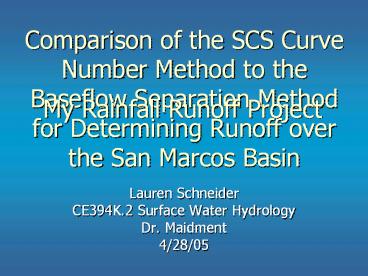Comparison of the SCS Curve Number Method to the Baseflow Separation Method for Determining Runoff o - PowerPoint PPT Presentation
Title:
Comparison of the SCS Curve Number Method to the Baseflow Separation Method for Determining Runoff o
Description:
Runoff/CN overestimated using land cover and soil group. Large variation from month to month ... CN table used might overestimate ... – PowerPoint PPT presentation
Number of Views:1188
Avg rating:3.0/5.0
Title: Comparison of the SCS Curve Number Method to the Baseflow Separation Method for Determining Runoff o
1
Comparison of the SCS Curve Number Method to the
Baseflow Separation Method for Determining Runoff
over the San Marcos Basin
My Rainfall Runoff Project
- Lauren Schneider
- CE394K.2 Surface Water Hydrology
- Dr. Maidment
- 4/28/05
2
Overview
- Purpose and Goals
- Background What are Curve Numbers?
- Data Gathered
- Methodology
- Curve Number Calculation
- Base Flow Separation
- Derivation of CN from real data
- Results
- Conclusions and Future Work
3
Purpose and Goals
- Purpose to compare the SCS CN method for
calculating runoff to runoff data - Goals
- Determine CNs for each watershed from land cover
and hydrologic soil group data - Separate base flow for stream gage data to get
runoff data - Derive CNs from runoff data
- Compare CNs
4
What are Curve Numbers?
- A curve number is an indicator of land
impermeability - Uses Land Use and hydrologic soil data
- Used to relate rainfall (in.) to runoff (in.)
- CN can be weighted for a watershed
- Generally used for small areas
5
Data Collection San Marcos Basin
6
(No Transcript)
7
(No Transcript)
8
(No Transcript)
9
Goal 1 Determine Watershed CN
Blanco River at Wimberley
10
Goal 1 Determine Watershed CN
11
Goal 2 Base Flow Separation
- Volume of runoff must be separated from stream
gage data - Base flow is the discharge NOT associated with a
rainfall event - Used BFI program
12
BFI Software
- A program for determining base flow
- Input comes directly from USGS stream gage data
- BFI (base flow)/(total flow) for the period
- Only significant parameter is N
13
BFI results
- The following graphs show the results of
separating base flow - Stream gage data from 1995
- Monthly runoff data was calculated from the BFI
results for the purpose of deriving the
watersheds CN
14
Base Flow Blanco at Wimberley
15
Base Flow Blanco Near Kyle
16
(No Transcript)
17
Base Flow SM at SM
18
Base Flow SM at Luling
19
Precipitation Data
- Monthly precipitation data was interpolated over
the watersheds
20
Goal 3 Derive CN from Data
- Monthly runoff and precipitation was used to find
CNs for each watershed
21
Results
- Base flow separation provided runoff/CN
- Runoff/CN overestimated using land cover and soil
group - Large variation from month to month
22
Conclusions
- Using CN to predict runoff for a large watershed
might give significant error - CN table used might overestimate
- Runoff data from base flow separation not
dependable for losing streams
23
Future Work
- Research other CN tables
- Use raster calculation instead of weighted CN
- Use larger N for base flow separation
- Determine a way to account for recharge from
stream - Analyze more years of data so that a statistical
analysis can be performed






![Chapter 3: Simplex methods [Big M method and special cases] PowerPoint PPT Presentation](https://s3.amazonaws.com/images.powershow.com/4471558.th0.jpg?_=202101090310)























